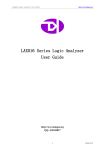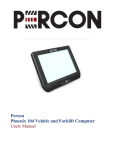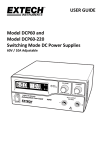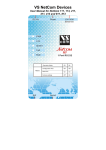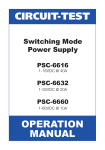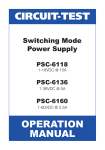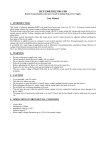Download Delta 36-655 Instruction manual
Transcript
(Model 36-655) Part No. 1238007 Dated 11-01-03 Copyright © 2003 Delta Machinery To learn more about DELTA MACHINERY visit our website at: www.deltamachinery.com. For Parts, Service, Warranty or other Assistance, please call 1-800-223-7278 (In Canada call 1-800-463-3582). INSTRUCTION MANUAL 10” Tilting Arbour Saw GENERAL SAFETY RULES 2 This manual contains information that is important for you to know and understand. This information relates to protecting YOUR SAFETY and PREVENTING EQUIPMENT PROBLEMS. To help you recognize this information, we use the symbols listed below. Please read the manual and pay attention to these sections. Indicates an imminently hazardous situation which, if not avoided, will result in death or serious injury. Indicates a potentially hazardous situation which, if not avoided, could result in death or serious injury. Indicates a potentially hazardous situation which, if not avoided, may result in minor or moderate injury. Used without the safety alert symbol indicates potentially hazardous situation which, if not avoided, may result in property damage. SOME DUST CREATED BY POWER SANDING, SAWING, GRINDING, DRILLING, AND OTHER CONSTRUCTION ACTIVITIES contains chemicals known to cause cancer, birth defects or other reproductive harm. Some examples of these chemicals are: · lead from lead-based paints, · crystalline silica from bricks and cement and other masonry products, and · arsenic and chromium from chemically-treated lumber. Your risk from these exposures varies, depending on how often you do this type of work. To reduce your exposure to these chemicals: work in a well ventilated area, and work with approved safety equipment, always wear MSHA/NIOSH approved, properly fitting face mask or respirator when using such tools. GENERAL SAFETY RULES READ AND UNDERSTAND ALL WARNINGS AND OPERATING INSTRUCTIONS BEFORE USING THIS EQUIPMENT. Failure to follow all instructions listed below, may result in electric shock, fire, and/or serious personal injury or property damage. SAVE! IMPORTANT SAFETY INSTRUCTIONS SAVE! Woodworking can be dangerous if safe and proper operating procedures are not followed. As with all machinery, there are certain hazards involved with the operation of the product. Using the machine with respect and caution will considerably lessen the possibility of personal injury. However, if normal safety precautions are overlooked or ignored, personal injury to the operator may result. Safety equipment such as guards, push sticks, hold-downs, featherboards, goggles, dust masks and hearing protection can reduce your potential for injury. But even the best guard won’t make up for poor judgment, carelessness or inattention. Always use common sense and exercise caution in the workshop. If a procedure feels dangerous, don’t try it. Figure out an alternative procedure that feels safer. REMEMBER: Your personal safety is your responsibility. This machine was designed for certain applications only. Delta Machinery strongly recommends that this machine not be modified and/or used for any application other than that for which it was designed. If you have any questions relative to a particular application, DO NOT use the machine until you have first contacted Delta to determine if it can or should be performed on the product. Technical Service Manager Delta Machinery 4825 Highway 45 North 1. FOR YOUR OWN SAFETY, READ INSTRUCTION Jackson, TN 38305 MANUAL BEFORE OPERATING THE TOOL. Learn the (IN CANADA: 505 SOUTHGATE DRIVE, GUELPH, ONTARIO N1H 6M7) tool’s application and limitations as well as the specific 8. MAKE WORKSHOP CHILDPROOF – with padlocks, hazards peculiar to it. master switches, or by removing starter keys. 2. KEEP GUARDS IN PLACE and in working order. 9. DON’T FORCE TOOL. It will do the job better and be 3. ALWAYS WEAR EYE PROTECTION. Wear safety safer at the rate for which it was designed. glasses. Everyday eyeglasses only have impact resistant 10. USE RIGHT TOOL. Don’t force tool or attachment to lenses; they are not safety glasses. Also use face or dust do a job for which it was not designed. mask if cutting operation is dusty. These safety glasses 11. WEAR PROPER APPAREL. No loose clothing, gloves, must conform to ANSI Z87.1 requirements. NOTE: neckties, rings, bracelets, or other jewelry to get caught in moving parts. Nonslip footwear is recommended. Wear Approved glasses have Z87 printed or stamped on them. protective hair covering to contain long hair. 4. REMOVE ADJUSTING KEYS AND WRENCHES. Form 12. SECURE WORK. Use clamps or a vise to hold work habit of checking to see that keys and adjusting wrenches when practical. It’s safer than using your hand and frees are removed from tool before turning it “on”. both hands to operate tool. 5. KEEP WORK AREA CLEAN. Cluttered areas and 13. DON’T OVERREACH. Keep proper footing and benches invite accidents. balance at all times. 6. DON’T USE IN DANGEROUS ENVIRONMENT. Don’t 14. MAINTAIN TOOLS IN TOP CONDITION. Keep tools use power tools in damp or wet locations, or expose them sharp and clean for best and safest performance. Follow to rain. Keep work area well-lighted. instructions for lubricating and changing accessories. 7. KEEP CHILDREN AND VISITORS AWAY. All children 15. DISCONNECT TOOLS before servicing and when changing accessories such as blades, bits, cutters, etc. and visitors should be kept a safe distance from work area. 3 16. USE RECOMMENDED ACCESSORIES. The use of accessories and attachments not recommended by Delta may cause hazards or risk of injury to persons. 17. REDUCE THE RISK OF UNINTENTIONAL STARTING. Make sure switch is in “OFF” position before plugging in power cord. In the event of a power failure, move switch to the “OFF” position. 18. NEVER STAND ON TOOL. Serious injury could occur if the tool is tipped or if the cutting tool is accidentally contacted. 19. CHECK DAMAGED PARTS. Before further use of the tool, a guard or other part that is damaged should be carefully checked to ensure that it will operate properly and perform its intended function – check for alignment of moving parts, binding of moving parts, breakage of parts, mounting, and any other conditions that may affect its operation. A guard or other part that is damaged should be properly repaired or replaced. 20. DIRECTION OF FEED. Feed work into a blade or cutter against the direction of rotation of the blade or cutter only. 21. NEVER LEAVE TOOL RUNNING UNATTENDED. TURN POWER OFF. Don’t leave tool until it comes to a complete stop. 22. STAY ALERT, WATCH WHAT YOU ARE DOING, AND USE COMMON SENSE WHEN OPERATING A POWER TOOL. DO NOT USE TOOL WHILE TIRED OR UNDER THE INFLUENCE OF DRUGS, ALCOHOL, OR MEDICATION. A moment of inattention while operating power tools may result in serious personal injury. 23. MAKE SURE TOOL IS DISCONNECTED FROM POWER SUPPLY while motor is being mounted, connected or reconnected. 24. THE DUST GENERATED by certain woods and wood products can be injurious to your health. Always operate machinery in well ventilated areas and provide for proper dust removal. Use wood dust collection systems whenever possible. ADDITIONAL SAFETY RULES FOR TABLE SAWS FAILURE TO FOLLOW THESE RULES MAY RESULT IN SERIOUS PERSONAL INJURY. 1. DO NOT OPERATE THIS MACHINE until it is assembled and installed according to the instructions. 2. OBTAIN ADVICE FROM YOUR SUPERVISOR, instructor, or another qualified person if you are not familiar with the operation of this machine. 3. FOLLOW ALL WIRING CODES and recommended electrical connections. 4. USE THE GUARDS WHENEVER POSSIBLE. Check to see that they are in place, secured, and working correctly. 5. AVOID KICKBACK by: A. keeping blade sharp and free of rust and pitch. B. keeping rip fence parallel to the saw blade. C. using saw blade guard and spreader for every possible operation, including all through sawing. D. pushing the workpiece past the saw blade prior to release. E. never ripping a workpiece that is twisted or warped, or does not have a straight edge to guide along the fence. F. using featherboards when the anti-kickback device cannot be used. G. never sawing a large workpiece that cannot be controlled. H. never using the fence as a guide when crosscutting. I. never sawing a workpiece with loose knots or other flaws. 6. ALWAYS USE GUARDS, SPLITTER, AND ANTIKICKBACK FINGERS except when otherwise directed in the manual. 7. REMOVE CUT-OFF PIECES AND SCRAPS from the table before starting the saw. The vibration of the machine may cause them to move into the saw blade and be thrown out. After cutting, turn the machine off. When the blade has come to a complete stop, remove all debris. 8. NEVER START THE MACHINE with the workpiece against the blade. 9. HOLD THE WORKPIECE FIRMLY against the miter gauge or fence. 10. NEVER run the workpiece between the fence and a moulding cutterhead. 11. NEVER perform “free-hand” operations. Use either the fence or miter gauge to position and guide the workpiece. 12. USE PUSH STICK(S) for ripping a narrow workpiece. 13. AVOID AWKWARD OPERATIONS AND HAND POSITIONS where a sudden slip could cause a hand to move into the blade. 14. KEEP ARMS, HANDS, AND FINGERS away from the blade. 15. NEVER have any part of your body in line with the path of the saw blade. 16. NEVER REACH AROUND or over the saw blade. 17. NEVER attempt to free a stalled saw blade without first turning the machine “OFF”. 18. PROPERLY SUPPORT LONG OR WIDE workpieces. 19. NEVER PERFORM LAYOUT, assembly or set-up work on the table/work area when the machine is running. 20. TURN THE MACHINE “OFF” AND DISCONNECT THE MACHINE from the power source before installing or removing accessories, before adjusting or changing set-ups, or when making repairs. 21. TURN THE MACHINE “OFF”, disconnect the machine from the power source, and clean the table/work area before leaving the machine. LOCK THE SWITCH IN THE “OFF” POSITION to prevent unauthorized use. 22. ADDITIONAL INFORMATION regarding the safe and proper operation of this tool is available from the Power Tool Institute, 1300 Summer Avenue, Cleveland, OH 44115-2851. Information is also available from the National Safety Council, 1121 Spring Lake Drive, Itasca, IL 60143-3201. Please refer to the American National Standards Institute ANSI 01.1 Safety Requirements for Woodworking Machines and the U.S. Department of Labor OSHA 1910.213 Regulations. SAVE THESE INSTRUCTIONS. Refer to them often and use them to instruct others. 4 POWER CONNECTIONS A separate electrical circuit should be used for your machines. This circuit should not be less than #12 wire and should be protected with a 20 Amp time lag fuse. If an extension cord is used, use only 3-wire extension cords which have 3prong grounding type plugs and matching receptacle which will accept the machine’s plug. Before connecting the machine to the power line, make sure the switch (s) is in the “OFF” position and be sure that the electric current is of the same characteristics as indicated on the machine. All line connections should make good contact. Running on low voltage will damage the machine. DO NOT EXPOSE THE MACHINE TO RAIN OR OPERATE THE MACHINE IN DAMP LOCTIONS. GROUND INSTRUCTIONS THIS MACHINE MUST BE GROUNDED WHILE IN USE TO PROTECT THE OPERATOR FROM ELECTRIC SHOCK. 2. Grounded, cord-connected machines intended for use 1. All grounded, cord-connected machines: on a supply circuit having a nominal rating less than 150 In the event of a malfunction or breakdown, grounding volts: provides a path of least resistance for electric current to If the machine is intended for use on a circuit that has an reduce the risk of electric shock. This machine is outlet that looks like the one illustrated in Fig. 1, the equipped with an electric cord having an equipment machine will have a grounding plug that looks like the plug grounding conductor and a grounding plug. The plug must illustrated in Fig. 1. be plugged into a matching outlet that is properly installed and grounded in accordance with all local codes and 3. 240 VOLT SINGLE PHASE OPERATION: ordinances. The motor supplied with your saw is a dual voltage, 120/240 volt motor. If it is desired to operate your saw at Do not modify the plug provided - if it will not fit the outlet, 240 volts, single phase, it is necessary to reconnect the have the proper outlet installed by a qualified electrician. motor leads in the motor junction box by following the Improper connection of the equipment-grounding conductor instructions given on the motor nameplate. can result in risk of electric shock. The conductor with insulation having an outer surface that is green with or MAKE SURE MOTOR IS without yellow stripes is the equipment-grounding DISCONNECTED FROM POWER SOURCE BEFORE conductor. If repair RECONNECTING MOTOR LEADS. It is also necessary or replacement of the electric cord or plug is necessary, do to replace the 120 volt plug, supplied with the motor, with not connect the equipment-grounding conductor to a live a UL/CSA Listed plug suitable for 240 volts and the rated terminal. current of the saw as illustrated in Fig. 2. Contact your Check with a qualified electrician or service personnel if the local Authorized Delta Service Center or qualified grounding instructions are not completely understood, or if electrician for proper procedures to install the plug. The in doubt as to whether the machine is properly grounded. saw must comply with all local and national electrical codes after the 240 volt plug is installed. Use only 3-wire extension cords that have 3-prong The saw with a 240 volt plug should only be connected grounding type plugs and matching 3-conductor receptacles to an outlet having the same configuration as the plug that accecpt the machine’s plug, as shown in Fig. 1. illustrated in Fig. 2. No adapter is available or should be used with the 240 Volt plug. Repair or replace damaged or worn cord immediately. Fig. 2 Fig. 1 IN ALL CASES, MAKE CERTAIN THE RECEPTACLE IN QUESTION IS PROPERLY GROUNDED. IF YOU ARE NOT SURE HAVE A QUALIFIED ELECTRICIAN CHECK THE RECEPTACLE. 5 EXTENSION CORDS Use proper extension cords. Make sure your extension cord is in good condition and is a 3-wire extension cord which has a 3-prong grounding type plug and matching receptacle which will accept the machine’s plug. When using an extension cord, be sure to use one heavy enough to carry the current of the machine. An undersized cord will cause a drop in line voltage, resulting in loss of power and overheating. Fig. 3A/B, shows the correct gauge to use depending on the cord length. If in doubt, use the next heavier gauge. The smaller the gauge number, the heavier the cord. MINIMUM GAUGE EXTENSION CORD MINIMUM GAUGE EXTENSION CORD RECOMMENDED SIZES FOR USE WITH STATIONARY ELECTRIC MACHINES RECOMMENDED SIZES FOR USE WITH STATIONARY ELECTRIC MACHINES Ampere Rating Volts 0-6 0-6 0-6 0-6 6-10 6-10 6-10 6-10 10-12 10-12 10-12 10-12 12-16 12-16 12-16 120 120 120 120 120 120 120 120 120 120 120 120 120 120 120 Total Length of Cord in Feet Guage of Extension Cord up to 25 25-50 50-100 100-150 up to 25 25-50 50-100 100-150 up to 25 25-50 50-100 100-150 up to 25 25-50 18 AWG 16 AWG 16 AWG 14 AWG 18 AWG 16 AWG 14 AWG 12 AWG 16 AWG 16 AWG 14 AWG 12 AWG 14 AWG 12 AWG GREATER THAN 50 FEET NOT RECOMMENDED Ampere Rating Volts 0-6 0-6 0-6 0-6 6-10 6-10 6-10 6-10 10-12 10-12 10-12 10-12 12-16 12-16 12-16 240 240 240 240 240 240 240 240 240 240 240 240 240 240 240 Fig. 3A Total Length of Cord in Feet up to 50 50-100 100-200 200-300 up to 50 50-100 100-200 200-300 up to 50 50-100 100-200 200-300 up to 50 50-100 Guage of Extension Cord 18 AWG 16 AWG 16 AWG 14 AWG 18 AWG 16 AWG 14 AWG 12 AWG 16 AWG 16 AWG 14 AWG 12 AWG 14 AWG 12 AWG GREATER THAN 100 FEET NOT RECOMMENDED Fig. 3B OPERATING INSTRUCTIONS FOREWORD Delta Model 36-655 is a 10” Tilting Arbour Saw. The Model 36-655 has a powerful 1-3/4 HP induction motor which can handle tough cutting operations. The Model 36-655 comes with a heavy duty fence system with a 30” rip capacity to the right of the blade and a 24” rip capacity to the left of blade. UNPACKING AND CLEANING Carefully unpack the machine and all loose items from the shipping container(s). Remove the protective coating from all unpainted surfaces. This coating may be removed with a soft cloth moistened with kerosene (do not use acetone, gasoline or lacquer thinner for this purpose). After cleaning, cover the unpainted surfaces with a good quality household floor paste wax. Figure 4 The basic saw unit is shipped as shown here. Fig. 4 NOTICE: THE MANUAL COVER PHOTO ILLUSTRATES THE CURRENT PRODUCTION MODEL. ALL OTHER ILLUSTRATIONS ARE REPRESENTATIVE ONLY AND MAY NOT DEPICT THE ACTUAL COLOR, LABELING OR ACCESSORIES AND MAY BE INTENDED TO ILLUSTRATE TECHNIQUE ONLY. 6 Fig. 5 Figure 5 The following saw parts require assembly. Please be sure all of the listed parts are included before starting assembly. 10. Leveling Pads (4) 1. Right Extension Wing with Hex Screws (3), 2. 3. 4. 11. Wrench Hook with Self Tapping Pan Head Screws (2) 12. Miter Gage Holder with Self Tapping Pan Head Screws (4) Flat Washers (3), and Lock Washers (3) Switch Assembly with Hex Screws (2) and Square Nuts (2) Splitter/Guard Assembly with Hex Head Screw (1), Special Washer (1), and Carriage Head Bolt (1) with Flatwasher (1), Lock Washer (1), Hex Nut (1) 13. Fence Holder Brackets (2) with Self Tapping Pan Head Screws (4) 14. Blade Wrenches (2) Dust Port with Pan Head Screws (4) and Hex Nuts (4) 15. Left Extension Wing with Hex Screws (3), Lock Washers (3), and Flat Washers (3) 16. Splitter Mounting Bracket with Hex Head Screws (2), Lock Washers (2) and Flat Washers (2) 5. Miter Gage Assembly 6. Table Insert with Button Head Screw (1) 7. Depth Stop Assembly with Special Washer (1), Socket Head Cap Screw (1), Lock Nut (1), Hex Socket Screws (2), Hex Nuts (2), and 17. Drive Belt 18. Handwheel (2) with Locking Knobs(2) Lock Knob (1). 8. Cross Cut Fence 9. Blade with Blade Flange (1) and Blade Hex Nut (1) 7 5 4 3 1 2 Fig. 6 Figure 6 1. Fence Assembly 2. Micro-adjust Assembly with Button Head Screws (2) 3. Front Rail with Square Head Screws (4), Flat Washers (4), Hex Nuts (4), End Caps (2), and Self Tapping Screws (2) 4. Rear Rail with Square Head Screws (4), Flat Washers (4), Hex Nuts (4), End Caps (2), and Self Tapping Screws (2) 5. Sliding Extension Table with Adjusting Brackets (2), Adjustment Pads (4), Special Washers (4), Self Tapping Screws (4), Hex Head Screws (8), Flat Washers (8), Lock Washers (8), and Hex Nuts (8) 8 ASSEMBLY INSTRUCTIONS FOR YOUR OWN SAFETY, DO NOT PLUG SAW INTO OUTLET UNTIL THE TOOL IS COMPLETELY ASSEMBLED AND YOU READ AND UNDERSTAND THE ENTIRE INSTRUCTION MANUAL. Installing Leveling Pads Figure 7 With basic saw unit (A) turned base up, thread the (4) adjustable leveling pads (B) into the bottom of cabinet. Use locking nuts to secure pad position once saw is upright and leveled. Fig. 7 Blade Tilting and Raising Handwheels Figure 8 Place blade tilting handwheel (A) onto shaft (B). Make certain slot (C) in handwheel is engaged with roll pin (D) on the shaft. Thread locking knob (E), in Fig. 9, onto shaft (B). Fig. 8 Figure 9 Assemble the blade raising handwheel (A) to the front of the saw in same manner. Fig. 9 Motor Packing Block Figure 10 Cut tape holding packing block (A) in place. Gently lower motor (B) and remove Block. 9 Fig. 10 Installing Drive Belt Figure 11 Lift up on motor (A) and assemble drive belt ( B) to the arbor pulley (C) and the motor pulley (D). The weight of the motor will provide the correct tension. Fig. 11 Attaching Extension Wings to Saw Table Figure 12 This view shows the left extension wing (A) attached. The right extension wing mounting screws (3), locking washers (3), and flat washers are aligned with the three threaded mounting holes (B). Fig. 12 Figure 13 Using the supplied hex head screws, lock washers, and flat washers (A), attach the extension wing (B) to the saw table. NOTE: Loosely tighten screws until next step is complete. Fig. 13 Figure 14 Using a straight edge (A), check the level of the extension wing (B) with the saw table (C). Once this is completed, tighten all three hex head screws. Fig. 14 10 Attaching Fence Rails and Sliding Extension Table Figure 15 Loosely attach square head screws (4), flat washers (4), and hex nuts (4) to the front edge of saw table and extension wings. Square heads are to be to the front. Fig. 15 Figure 16 Slide front rail (A) over square head screws using channel (B) on back side of rail. Extend right side of front rail 17 3/ 4” past edge of right extension wing, then tighten all screws. Fig. 16 Figure 17 Attach rear rail (A) in same manner as front rail. Extend rear rail 12 1/2” past edge of right extension wing. Tighten all screws. Fig. 17 Figure 18 With sliding extension table (A) flipped over, loosely assemble adjusting brackets (B) and hardware as indicated. Fig. 18 11 Figure 19 Mount sliding extension table (A) into front and rear rail channels (B) using adjustment pads (C). Adjust pads for a smooth but snug fit. Fig. 19 Figure 20 Using a straight edge (A), check the level of the sliding table (B) with the right extension wing (C). Once this is completed, tighten all screws. Fig. 20 Blade Guard and Splitter Assembly DISCONNECT TOOL FROM POWER SOURCE. Figure 21 Fasten the splitter mounting bracket (A) to the rear trunion using supplied hex head screws (2), lockwashers (2), and flat washers (2). Do not completely tighten the two screws (B) at this time. Fig. 21 Figure 22 Raise the saw arbor to its hightest position. Using a straight edge (A), check to see if the inside splitter bracket (B) is aligned with the inner arbor flange (C). Fig. 22 12 Figure 23 If alignment is necessary, loosen the two screws (A), align bracket (B) with the arbor flange and tighten screws (A). Loosely assemble large washer and hexhead screw (C) to the inside splitter bracket (B). Fig. 23 Figure 24 Install the blade guard and splitter assembly (A) between the large washer (B) and the splitter bracket. Tighten hex head screw. Fig. 24 Figure 25 Fasten the rear of the blade guard and splitter bracket assembly (A) to the rear splitter mounting bracket (B) using supplied carriage head screw (1), lockwasher (1), flat washer (1), and hex nut (1). Securely tighten screw assembly(C). Fig. 25 Figure 26 The splitter (A) has a notch (B) cut in the top edge. This feature will enable the blade guard to stay in the raised position to make blade changing easier. Raise the front of blade guard (C) until the rear edge slips into notch (B). The blade guard will stay in this position. Fig. 26 13 Installing Blade DISCONNECT TOOL FROM POWER SOURCE. Figure 27 With the blade guard (A) in the raised position, assemble the saw blade (B) on the saw arbor using the two blade wrenches. Fig. 27 Figure 28 This view shows proper mounting of blade with teeth facing front of machine. NOTE: When installing blade, thread arbor nut counterclockwise onto saw arbor. Fig. 28 Aligning Blade with Splitter DISCONNECT TOOL FROM POWER SOURCE. Figure 29 Using a straight edge (A), check to see if the saw blade is aligned with the rear of splitter (B). If alignment is necessary, loosen screws (C), align splitter (B) with the saw blade, and tighten screws (C). Fig. 29 Table Insert DISCONNECT TOOL FROM POWER SOURCE. Figure 30 Lower saw blade and install table insert (A). The table insert should be level with the table surface. (If an adjustment is necessary, see the section “Adjusting Table Insert”.) Lock table insert in place using button head screw (B). NOTE: When installing, the table insert will automatically release and lower the table guard (C). Fig. 30 14 Installing Switch DISCONNECT TOOL FROM POWER SOURCE. Figure 35 Mount switch (A) using hex head screws (2) and square nuts (2). Install screws with square nuts facing up (B). Do not tighten screws. Fig. 35 Figure 36 Slide square nuts (B) into bottom channel of front rail. Fig. 36 Figure 37 Move switch (A) along front rail to a convenient position. Tighten the two screws. Run the switch to motor cord (shortest) (B) up over cabinet top. Make connection with motor cord (C). Fig. 37 Figure 38 Attach motor cord (A) to inside of cabinet using supplied cable clamp, hex screw, lock washer, and flat washer (B). Fig. 38 15 Tool Holders and Rail End Caps Figure 39 Install front and rear end caps (A) on both ends of fence rails using self tapping screws (4). Install fence holders (B) using self tapping pan head screws (4). Install wrench hook (C) using self tapping pan head screws (2). Install miter gage holder (D) using self tapping pan head screws (4). Fig. 39 Dust Port DISCONNECT TOOL FROM POWER SOURCE. Figure 40 Attach dust port (A) to saw cabinet using pan head screws (4) and hex nuts (4). Fig. 40 Fence and Micro-Adjusting Knob DISCONNECT TOOL FROM POWER SOURCE. Figure 41 Turn fence body (A) on its side. Attach micro-adjusting knob (B) to fence using button head screws (2). Fig. 41 Figure 42 With the fence locking handle (A) in the raised position, lower the rip fence (B) onto the fence rail (C). Lock the rip fence by pushing down handle (A). Fig. 42 16 Miter Gage DISCONNECT TOOL FROM POWER SOURCE. Figure 43 The miter gage (A) is equipped with a T-slot bar (B). Engage bar at end of miter slot (C) and slide miter gage onto saw table. Fig. 43 Cross Cut Fence with Depth Stop DISCONNECT TOOL FROM POWER SOURCE. Figure 44 Install hex socket screws (2) and M5 nuts (2) thru miter gage body (A). Slide cross cut fence (B) over screws and onto miter gage assembly using channel (C) on side of fence. Tighten screws with fence at desired position. Note the assembled depth stop (D). Fig. 44 Figure 45 Attach depth stop assembly (A) by sliding onto cross cut fence (B) using channel (C) on top of fence. Lock depth stop using lock knob (D). Fig. 45 17 OPERATING CONTROLS AND ADJUSTMENTS Starting and Stopping the Saw Raising and Lowering Blade Blade Tilting Adjustment Figure 46 To apply power to the saw, depress the upper (green) button on switch (A). Pressing the lower (red) button turns the power OFF. DISCONNECT TOOL FROM POWER SOURCE. Fig. 46 The blade can be raised or lowered by unlocking knob (B) and turning the handwheel (C). To raise the blade, turn handwheel clockwise. To lower the blade, turn handwheel counterclockwise. Tighten knob (B) when height is set. The saw blade can be set at any angle between 90 degrees and 45 degrees. To tilt the blade, unlock knob (D) and turn handwheel (E) to desired blade angle. A blade tilt gage (F) is provided for angle accuracy. Adjusting 90 Degrees and 45 Degrees Positive Stops DISCONNECT TOOL FROM POWER SOURCE. Figure 47 Raise the blade to its highest position. Set blade at 90 degrees to the table. Use a square (A) and check accuracy. If an adjustment is necessary, loosen set screw (B) with a hex wrench. Find 90 degrees, then turn set screw clockwise until it bottoms. Set blade at 45 degees to the table. Use a combination square and check accuracy. If an adjustment is necessary, loosen set screw (C) with a hex wrench. Find 45 degrees, then turn set screw clockwise until it bottoms. If necessary, reset tilt gage. Fig. 47 Backlash Adjustments for Blade Raising and Blade Tilting Mechanisms DISCONNECT TOOL FROM POWER SOURCE. Figure 48 If any play is detected in the blade raising or blade tilting mechanisms, the following adjustments should be made. Fig. 48 Adjusting Blade Raising Mechanism - Loosen lock nut (A) and turn eccentric sleeve (B) until all play is removed in mechanism, then tighten lock nut (A). Adjusting Blade Tilting Mechanism - Loosen lock nut (C) and turn eccentric (D) until all play is removed. Tighten lock nut (C). 18 Rip Fence Adjustments DISCONNECT TOOL FROM POWER SOURCE. Figure 49 Slide fence (A) against one edge of the miter gage slot (B). Lock the fence handle (C). The edge of the fence should be parallel with the edge of the miter gage slot. Fig. 49 Figure 50 If an adjustment is necessary loosen the four hex screws (A). Make the necessary correction, then tighten screws (A). Fig. 50 Figure 51 Once the fence is aligned with the miter gage slot, raise the saw blade (A) to its highest position. Slide fence (B) against blade and lock fence in that position by pushing down on locking handle (C). Fig. 51 Figure 52 The right cursor witness line (A) should line up with the “Zero” mark on scale (B). If it does not, loosen screw (C) and adjust cursor (D). Tighten screw. For fence operations left of the blade, repeat procedure but use left cursor. Fig. 52 19 Setting Fence Micro-Adjust Figure 53 Release locking handle (A). Push in micro-adjust knob (B) to engage mechanism, then turn handle right or left for precise settings. Release micro-adjust knob (B) and lock handle (A). Fig. 53 Figure 54 The miter gage is equipped with a T-slot bar (A) that allows it to extend past the front of table. The miter gage body (B) can be turned right or left for angle cross-cutting. Loosen lock knob (C), choose angle, and tighten lock knob. The miter gage is also equipped with adjustable index stops at 90 degrees (D) and 45 degrees right and left (E). Fig. 54 Adjusting Table Insert DISCONNECT TOOL FROM POWER SOURCE. Figure 55 Place a straight edge (A) across the table at both ends of the table insert. The table insert (B) should always be level with the table. If an adjustment is necessary, turn the four adjusting screws (B), as needed. The table is equipped with a finger hole (C) for easy removal. Fig. 55 20 MAINTENANCE Changing the Saw Blade DISCONNECT TOOL FROM POWER SOURCE. Use only 10” Diameter Blades with 5/8” Arbor Holes, rated at 3450 RPM or Higher Figure 56 Remove table insert (A) and raise saw blade (B) to its maximum height. Fig. 56 Figure 57 Place the open end wrench on the flats of the saw arbor to keep the arbor from turning. Using the box wrench, turn arbor nut toward the front of the saw. Remove arbor nut, blade flange, and saw blade. Assemble the new blade, making sure the teeth point down at the front of the saw table, and assemble outside blade flange and arbor nut. With open end wrench on the flats of the arbor, tighten arbor nut by turning box wrench counterclockwise. Replace table insert. Fig. 57 21 NOTES 22 NOTES 23 ACCESSORIES A complete line of accessories is available from your Delta Supplier, Porter-Cable • Delta Factory Service Centers, and Delta Authorized Service Stations. Please visit our Web Site www.deltamachinery.com for a catalog or for the name of your nearest supplier. Since accessories other than those offered by Delta have not been tested with this product, use of such accessories could be hazardous. For safest operation, only Delta recommended accessories should be used with this product. PARTS, SERVICE OR WARRANTY ASSISTANCE All Delta Machines and accessories are manufactured to high quality standards and are serviced by a network of Porter-Cable • Delta Factory Service Centers and Delta Authorized Service Stations. To obtain additional information regarding your Delta quality product or to obtain parts, service, warranty assistance, or the location of the nearest service outlet, please call 1-800-223-7278 (In Canada call 1-800-463-3582). Two Year Limited Warranty Delta will repair or replace, at its expense and at its option, any Delta machine, machine part, or machine accessory which in normal use has proven to be defective in workmanship or material, provided that the customer returns the product prepaid to a Delta factory service center or authorized service station with proof of purchase of the product within two years and provides Delta with reasonable opportunity to verify the alleged defect by inspection. Delta may require that electric motors be returned prepaid to a motor manufacturer’s authorized station for inspection and repair or replacement. Delta will not be responsible for any asserted defect which has resulted from normal wear, misuse, abuse or repair or alteration made or specifically authorized by anyone other than an authorized Delta Service facility or representative. Under no circumstances will Delta be liable for incidental or consequential damages resulting from defective products. This warranty is Delta’s sole warranty and sets forth the customer’s exclusive remedy, with respect to defective products; all other warranties, express or implied, whether of merchantability, fitness for purpose, or otherwise, are expressly disclaimed by Delta.
























